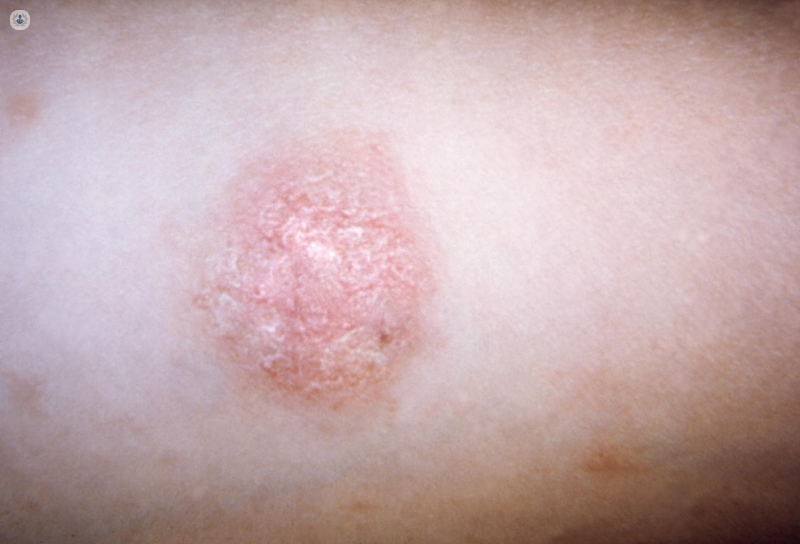Squamous cell carcinoma
Dr Eleanor Mallon - Dermatology
Created on: 03-02-2017
Updated on: 06-08-2023
Edited by: Sophie Kennedy
What is squamous cell carcinoma?
Squamous cell carcinoma (SCC) is the second most common form of skin cancer. It develops in the squamous cells in the epidermis, located near the skin's surface. It is a type of malignant tumour. Most often, the skin is affected by SCC but it can also develop on other parts of the body where squamous cells are found, such as the mouth, throat or lungs.
When SCC presents as skin cancer, it begins as a small, firm and pink nodule, which can develop into a larger ulcer, and usually arises in the sun-exposed areas of the body. It has the appearance of long-lasting, rough, scaly, thick patches, which sometimes have a spiky horn sticking up from the surface. The lump feels tender and can bleed if scratched, knocked or struck. It may appear similar to warts or open sores with raised edges and a crusty surface.

What are the symptoms of squamous cell carcinoma?
Squamous cell cancers tend to appear in sun-exposed areas of the body, such as the face, ears, neck, lips and back of the hands. They can also appear, although less frequently, on the skin of the genital area. At other times, they can arise in scars or skin sores that appear in other areas of the body.
SCC can appear in the following ways:
- Red spots that are rough or scaly and may bleed or scab over
- Bigger growths, sometimes with a lower area in the centre
- Open sores that do not heal or that heal and come back
- Wart-like growths
Seek medical attention if you have a scab or sore that does not heal in two months, or a flat patch of scaly rough skin that doesn't go away.
What causes squamous cell carcinoma?
The main cause of squamous cell carcinoma is overexposure to ultraviolet (UV) light from the sun, sunlamps and artificial tanning sunbeds. DNA damage from UV overexposure triggers abnormal changes in the squamous cells.
Other risk factors include:
- Having had skin cancer in the past
- Having a family history of skin cancer
- People with light skin, light hair and blue or grey eyes with easily sunburned pale skin
- Having a large number of freckles or moles
- Taking immunosuppressant medication or having a weakened immune system due to a co-existing medical condition
- Being over 50 years old - more sun exposure and sun damage are accumulated over the years
- Being male - men are twice more likely to be diagnosed with squamous cell carcinoma than women
- Having chronic infections and skin inflammations from scars, burns and other conditions
How is squamous cell carcinoma diagnosed?
If a patient reports any suspicious signs, a doctor will examine the skin and may commission tests to determine if it is cancer or another skin problem. Other tests may be performed if there is a chance that the skin cancer has spread to other parts of the body, known as metastasis.
Medical history and a physical examination
The specialist will ask the patient about their symptoms, including when the skin sore first appeared, if it has changed in size or appearance and if it has caused pain or bleeding. They may also ask if the patient has previously been exposed to conditions related to skin cancer or if there is a family history of skin cancer.
Skin biopsy
If the doctor suspects a lesion may be cancerous, a sample will be removed, known as a biopsy, and sent to a laboratory for closer analysis. If the biopsy removes the tumour entirely, this is all that is required for early-stage squamous cell cancers, without further treatment being needed.
How long does it take for squamous cell carcinoma to metastasize?
While SCC tends to spread more quickly than other skin cancers, like basal cell carcinoma, for example, squamous cell carcinoma is generally considered a slow-growing type of cancer.
As such, it is rare for squamous cell carcinoma to spread to another part of the body. If metastasis does occur, the malignancy will usually spread slowly, allowing for the majority of cases to be diagnosed before the cancer has spread beyond the skin's upper layer.
How does squamous cell carcinoma spread?
The different stages of squamous cell carcinoma cancer are:
- Stage 0: Also called carcinoma in situ, cancer is only found in the original tumour site in the skin's epidermis. It has not spread to the dermis.
- Stage 1: The tumour is 2cm wide or smaller and it has started to grow deeper into the skin. It has one high risk feature (for example, metastasis to nerves)
- Stage 2: The tumour may have spread into the dermis and it may also have one or more high risk feature, but it has not spread to lymph nodes or distant tissue. It is larger than 2cm.
- Stage 3: The tumour has metastasized to areas below the skin, including the muscle or lymph nodes, but only to those areas that are near the original tumour site. It has not metastasized to distant organs.
- Stage 4: The cancer has spread to nearby lymph nodes, organs like the brain, bones or the skull base. It is large, of any size.
Can squamous cell carcinoma affect the bones or the brain?
Squamous cell carcinoma can metastasize to one or more distant organs from where it first originated, such as the lungs, liver or even the brain. It will rarely affect the bones or any other part of the skeletal system, except the skull, due to the absence of squamous cells in bones.
How is squamous cell carcinoma treated?
Many squamous cell skin cancers are detected and treated in the early stages, at which time they can be removed with local treatment methods. Generally, minor squamous cell cancers can be cured with these treatments. Other more advanced squamous cell cancers are more difficult to treat, and cancers that grow quickly have a higher risk of coming back.
Surgery
There are different types of surgery to treat squamous cell skin cancers.
- Excision: The tumour is removed along with a small margin of normal skin cells. The patient may need to return for additional excision if cancer cells are found beyond the margin. This surgery is generally used for small squamous cell carcinomas in an early phase that have not spread.
- Curettage and electrodessication: This method is useful in the treatment of minor squamous cell cancers, but it is not recommended for larger tumours. With this type of electrosurgery, the surgeon scrapes or shaves off the tumour with a curette. Heat is then used to stop the bleeding and destroy any remaining cancer cells. The procedure is repeated during the same session until there are no cancer cells.
- Mohs surgery: This operation is especially useful to treat squamous cell cancers more than 2cm wide or with poorly defined edges; for those cancers that have come back after treatment; for cancer that has spread throughout nerves under the skin and for localised cancer in certain areas of the face or genital area. In Mohs surgery, the visible tumour and a very small margin of tissue around and beneath the tumour site is removed. The surgeon will keep removing tissue exactly where the cancer cells are, until there is no sign of cancer. The wound may then be closed or allowed to heal on its own. This is the most effective technique for squamous cell carcinomas because it achieves the highest cure rate whilst also sparing the highest amount of healthy tissue.
In some cases, squamous cell cancers can spread to the lymph nodes or to different parts of the body. In such cases, it may be necessary to administer treatments such as radiation therapy, chemotherapy or both. Photodynamic therapy may also be used.
Radiotherapy
Sometimes radiation therapy with low energy X-ray beams is a good option for patients with larger tumours, specifically in areas where surgery is difficult or for patients who cannot undergo surgery. This treatment is not used as much as the initial treatment in younger patients due to the possible risk of long-term problems.
Cryotherapy
Cryosurgery is used in some early-stage squamous cell cancers, specifically in people who cannot undergo surgery, but it is not recommended for larger invasive tumours, or tumours in certain parts of the nose, ears, eyelids, scalp or legs. The doctor uses an applicator or a spray to apply liquid nitrogen onto the tumour, which freezes and destroys it. The tumour falls off, allowing healthy skin to emerge beneath.
Photodynamic therapy
This treatment option is mostly used for superficial squamous cell carcinomas on the face and on the scalp, as well as actinic keratoses (lesions that anticipate squamous cell carcinoma.) With photodynamic therapy, a light-sensitizing topical agent is applied on top of the tumour. After absorption, a strong laser is directed at the tumour, activating the topic agent which kills cancer cells and spares healthy tissue.
Treatment might also include anti-cancer creams (known as topical chemotherapy) that are applied directly onto the skin cancer for several weeks, or immunotherapy, which is considered for advanced cancers when other treatments are no longer suitable.
Although the majority of squamous cell carcinomas can be successfully treated, if left untreated, the lumps can invade deeper layers of the skin and spread to other parts of the body, causing severe skin damage, becoming dangerous and possibly even fatal.
Can squamous cell carcinoma recur?
For a small number of people (with large and advanced squamous cell carcinomas), the cancer may never go away completely and will recur (return) after treatment. Regular treatment with radiotherapy or chemotherapy may help to manage the cancer and prevent it from developing further, but this will be determined by the location of the cancer and the type of treatments that patients have had before.
People who have had squamous cell carcinoma are at a high risk of developing other skin cancers in different parts of the body. Close follow-up visits after treatment, sun protection and monthly skin examinations at home are important to reduce the risk.
What is the prognosis of squamous cell carcinoma?
When diagnosed and treated early, most squamous cell carcinoma cases are successfully cured. The five-year survival rate is between ninety-five and ninety-nine per cent, with the remaining percentage representing advanced cases that are very dangerous and difficult to treat. However, this five-year survival rate drops to less than fifty per cent if the cancer spreads past the skin's epidermis layer.
What type of doctor treats squamous cell carcinoma?
Dermatologists treat most skin cancers, as well as pre-cancers, including squamous cell carcinomas. If the cancer is more advanced or if you require further treatment, you may be referred to a surgical oncologist (surgery treatment), a radiation oncologist (radiation therapy) or a medical oncologist (chemotherapy).
Either a dermatologist or a Mohs surgeon will surgically remove the squamous cell carcinoma tumour(s) during an clinic visit.
How do you prevent squamous cell carcinoma?
There is no certain way to prevent squamous cell skin cancer. Risk factors like age, gender and family history cannot be controlled. However, there are some things that can reduce your risk, including:
- Limit exposure to UV rays and use high SPF sunscreen to protect yourself, even if it is not sunny outside
- Look out for new or changing wounds that grow, bleed or do not heal
- See a dermatologist if you notice a suspicious spot in your body
- Have annual professional skin exams (carried out by a dermatologist)
- Avoid tanning beds or sunlamps, as they give off UV rays
Which is more serious: squamous cell carcinoma or melanoma?
Although both squamous cell carcinoma and melanoma are skin cancers, melanoma is the most dangerous type, because it is very likely that it will metastasize beyond the original tumour site to other parts of the body if not caught and treated early. It will also metastasize very quickly, being very difficult to predict when exactly it will occur.


